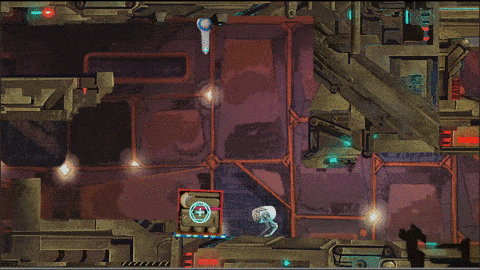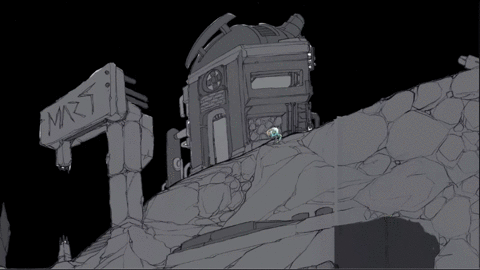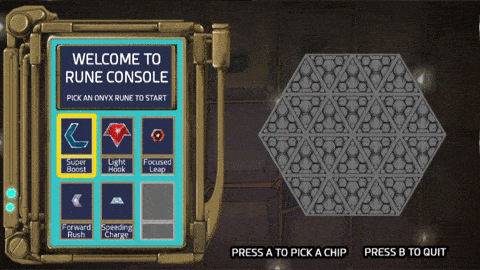Good day, Ascenderians.
Today, I, Chalcedony, the programmer of Ascender, also an intern in devlogging, am going to tell you an important element of Ascender – the rune system. But before we start, let me give you a sneak peek at what feature is being cooked in our kitchen. It’s your turn, Sky!

Yes, we plan to extend the usage of hook, so you soon will be able to see Sky happily yanking boxes around Dolopo. Oh, about Dolopo, here’s an animated GIF showing sketches of that city.

Enough peeking! Without further ado, let’s get into the rune system! What is rune, you say? Hey, don’t make that what’s-wrong-by-not-knowing-it face! Check this blog post by Amethyst, you will get an explanation why it’s so awesome that it brought us the title “Leading Engineers of Game Mechanics” from Compfest, a prestigious information technology event in Indonesia. Or better yet, play the prototype now!
Alternatively, I’ll just be nice and once again copy-paste his explanation for you.
“So what is Rune? Rune is type of stone that can be found by the player. Each rune can equip Sky with new skill in order to explore the world of Ascender. The trick is that each rune can be only equipped in a limited slot. Player need to figure out how to equip rune effectively and efficiently”.

You might have known from the image (or by playing the prototype) that the rune system is placed on a triangular grid. I found that triangular grid suits well with what we need – a simple grid type so anyone would have no trouble fitting the rune in, but not too simple to maintain the ‘puzzleness’ and to preserve some rooms to make it more interesting.
This rune system is appealing, but we want to make it fascinating. We have considered some ideas, such as combining runes to produce new skills, e.g. Fire + Run = able to walk on fire, Strong + Hook = able to pull heavier blocks, etc. We also thought about more rune placement rules, such as which rune must be put close to each other, and which should not, and its consequences.
Along with those thoughts, we also want the rune system to develop as the game progresses. Runes (and slots for runes) will be awarded upon quest completion, and maybe at some other rare occasions.
Now you know the charm of rune system in Ascender, let’s talk a bit about the implementation, a.k.a. the annoying math and programming stuffs. First thing first: How can we construct a coordinate system for this grid? Actually, there has already some solutions on the net, with this being on top of the search result:

The implementation was straightforward. Here, we choose (0, 0, L) as the origin, and assign the triplet (x, y, z) to each triangle slot, with x and y being integers and z being L or R. Note that for each increment of x by 1, we move right exactly 1 triangle length, and for each increment of y by 1, we move up exactly 1 triangle height, and right by 0.5 triangle length. If z is L, the triangle is upright, but if it is R, it is upside down and shifted right by 0.5 unit of triangle length.
Then another problem jumped out when we needed the rune so it can be rotated. Now how do you map some point to another when it is rotated around the origin by 60 degrees? Try it – you will know that it’s not a trivial process (except maybe you are some geometry whiz, that’s it).

After some hours thinking, I decided to play with some other coordinate system, like this one below.

Now, the coordinate only needs x and y, but it omit some points as it is not valid to put a triangle in, such as point (0, 0). All valid points have odd y coordinate. Moreover, we need to derive a formula to know whether the triangles should be upright or upside-down. On top of that, the distance in y-axis is shorter than x-axis (it’s approximately 0.87 times, = 0.5 tan 60)). It looks totally uglier than what we had before. But, by some magic process, I then found a way to map it!
Imagine we are to rotate point (x, y) by 60 degrees. By using rotation matrix, we have the new point (x’, y’) to be (x cos 60 – y sin 60, x sin 60 + y cos 60). But remember that the y-axis is ‘shorter’ by half of tan 60 times than the x-axis! All in all, it turns out to be easier after we done those trigonometry calculations. Aw, yeah! Simply put, convert from integer coordinate to Cartesian, do rotation, then convert back to our integer coordinate system.
Well, that’s one problem about Ascender’s rune system solved. But we still have plenty things to experiment with, and we need your help for that! Remember about making it fascinating? How about some suggestions in these things.
- What other platforming skills would you like to see?
- Is combining runes compelling? What rune combination do you suggest?
- What rune placement rule do you think is intriguing? Are there any game which you must put puzzle piece in interesting ways?
- Do you have any ideas to make the rune system (or even the whole game) more engaging?
If you have any thoughts, fill the comment section below and we will be very glad to hear it.
Now, for a closing, check out Ascender’s Starter Bundle: You’ll get the release version of Ascender (when it is released, of course), together with some exclusive rare items, such as digital wallpaper, soundtrack, mouse pad, and a 4GB flash disk! As a bonus, we also included 3 of our games inside! Alas, it’s for sale in Indonesia only, though.

Whew, this is the longest blog entry so far, but now is the time for us to part. Always keep this blog in sight, though, as future updates might pop up anytime soon! Thanks for reading!
Chalcedony








